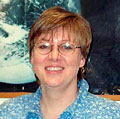 |
|
|
| Author |
Message |
Patty_Cie

Joined: 23 Mar 2004
Posts: 87

|
 Posted:
Wed Jun 02, 2004 6:51 pm Posted:
Wed Jun 02, 2004 6:51 pm |
  |
May 29, 2004 Saturday
10:00 PM Alaska time
We continue to travel through thick ice, however, we are on the East Hanna Shoal transect line. The scientists call this line a high-resolution line, which means the stations are close together. We have completed two short stations today. At a short station only a CTD service cast is made and sometimes the Video Plankton Recorder (VPR) is deployed. The next station will be a long station, also called a process station, where all sampling occurs.
During the short stations, I talked to Ev Sherr from Oregon State University. Ev is working on a piece of the food web puzzle. She is investigating how much phytoplankton microzooplankton eat over a specific time period; also known as the grazing rate. Remember phytoplankton is plant-like algae and diatoms that move with the ocean currents. Phytoplankton is the primary producer (i.e. the beginning) of the ocean food web. Zooplankton, on the other hand, is the animal-like protist, animal larvae and eggs that move with the ocean currents. To be a member of the microzooplankton, a protist must measure less than 200 microns. Most of the protists Ev studies measure half to one-quarter the width of a human hair. Microzooplankton are the first consumers of the food web.

A 35 micron microzooplankton with digested phytoplankton. Ev took this photo with an epifluorescence microscope. Most microscopes shine the light up through the slide to your eye. Epi means top so epifluorescence microscope shines light from the top down through the slide. This picture is published with Ev Sherr’s permission.
To study the grazing rates of microzooplankton on phytoplankton, Ev and her technician, Sybille Pluvinage, use a technique called a dilution assay. The dilution assay allows Ev to make grazing comparisons. In theory, she should see a lower phytoplankton growth rate in whole seawater (where there are more grazing microzooplankton present) and higher phytoplankton growth rates in the more diluted seawater (where there should be fewer grazers present).

Ev Sherr carefully examines the data collected by the CTD sensors to select her water depth.
To set up a dilution assay Ev and Sybille make various concentrations of whole seawater (collected at depth from the rosette bottles on the CTD package) with 0.2 micron filtered water. The concentrations they use are: whole (100%) seawater, 80% seawater to 20% filtered water, 60% seawater to 40% filtered water, 40% seawater to 60% filtered water, 20% seawater to 80% filtered water and 10% seawater to 90% filtered water. They pour the different concentrations into two-liter bottles. The bottles are put into plastic cylinders. The cylinders are wrapped with screening to reduce the amount of solar radiation exposure, thereby, imitating the light levels found at the water depth where the plankton was collected. Without screening, the phytoplankton can bleach which may cause skewed chlorophyll results.

Sybille Pluvinage prepares the distillation bottles.
The bottles are measured for beginning chlorophyll concentrations and placed in an incubator located on the bow of the Healy for 48 hours. After 48 hours the chlorophyll concentrations are measured again to get an ending chlorophyll value. By comparing the beginning chlorophyll levels to the ending chlorophyll levels, Ev can determine the growth rate of the phytoplankton in each bottle. With less grazing, phytoplankton grows faster. Lower phytoplankton growth rates in the 100% seawater bottles means grazing has occurred. To quantify phytoplankton numbers in her study, Ev uses a machine called a flow cytometer. A flow cytometer counts the number of cells in a sample.

The incubator Ev Sherr uses in her microzooplankton study is located on the bow of the Healy.
To see photographs taken by Steve Roberts of UCAR/JOSS, click here. |
|
|
    |
 |
|
|
|
View next topic
View previous topic
You cannot post new topics in this forum
You cannot reply to topics in this forum
You cannot edit your posts in this forum
You cannot delete your posts in this forum
You cannot vote in polls in this forum
You cannot attach files in this forum
You can download files in this forum
|
Powered by phpBB 2.0.11
© 2001, 2002 phpBB Group :: FI Theme ::
All times are GMT
| |
